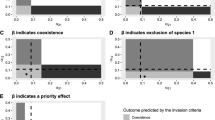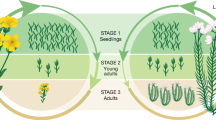Abstract
We consider a discrete time model of semelparous biennial population dynamics. Interactions between individuals are modelled with the aid of an ``environmental'' variable I. The impact on and the sensitivity to the environmental condition is age specific. The main result is that competitive exclusion between the year classes is possible as is their coexistence. For moderate values of the basic reproduction ratio R 0 there is a strict dichotomy: depending on the other parameters we either find competitive exclusion or coexistence. We characterize rather precisely the patterns of age specific impact and sensitivity that lead to either of these outcomes.
Similar content being viewed by others
Author information
Authors and Affiliations
Additional information
Received: 13 July 2001 / Revised version: 26 June 2002 / Published online: 19 November 2002
Key words or phrases: Competitive exclusion – Semelparous species – Periodical insects
Rights and permissions
About this article
Cite this article
Davydova, N., Diekmann, O. & van Gils, S. Year class coexistence or competitive exclusion for strict biennials?. J. Math. Biol. 46, 95–131 (2003). https://doi.org/10.1007/s00285-002-0167-5
Issue Date:
DOI: https://doi.org/10.1007/s00285-002-0167-5




